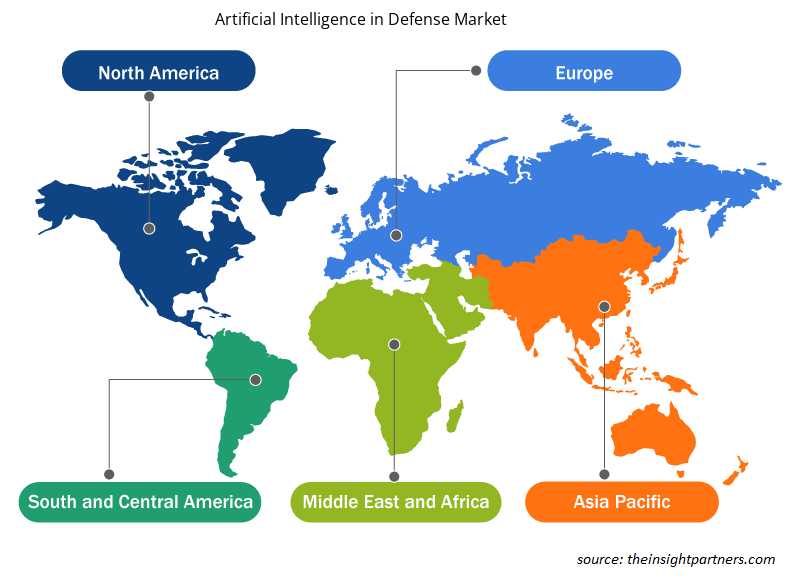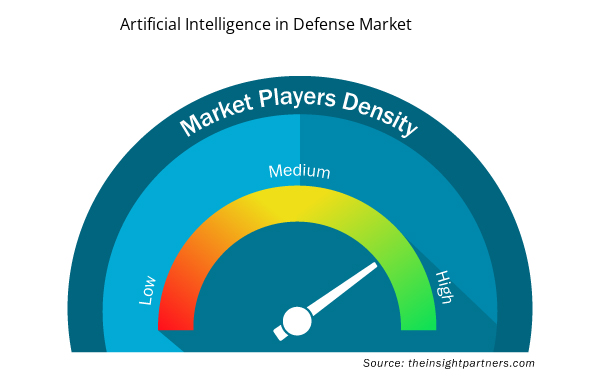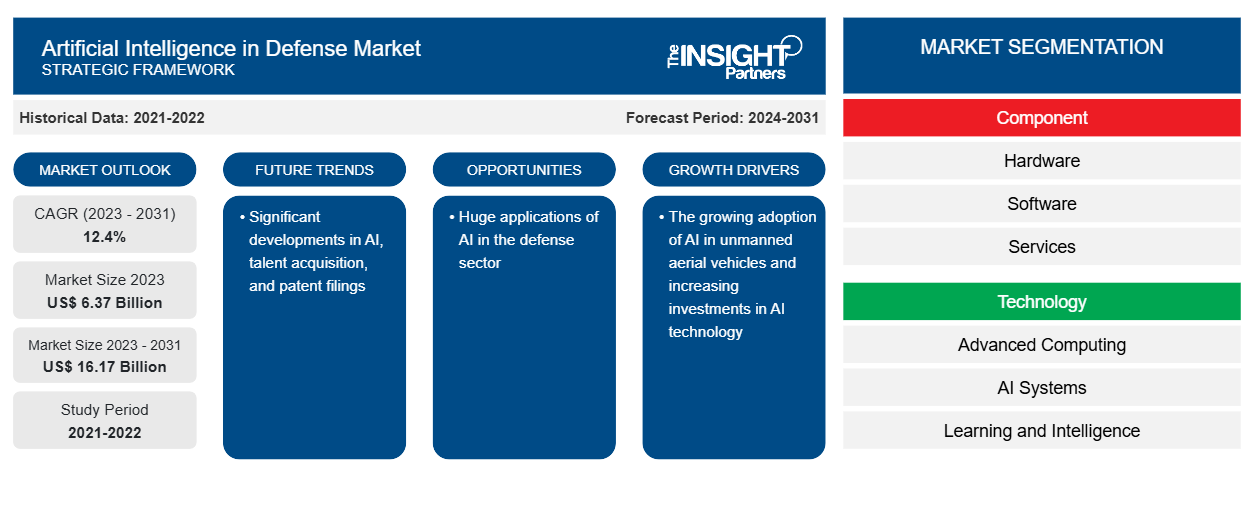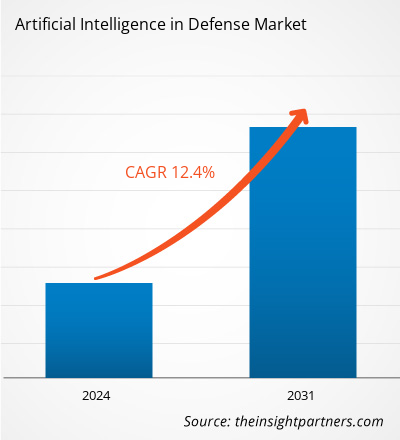防衛分野における人工知能の市場規模は、2023 年の 63.7 億米ドルから 2031 年には 161.7 億米ドルに達すると予測されています。市場は 2023 年から 2031 年にかけて 12.4% の CAGR を記録すると予想されています。AI、人材獲得、特許出願における大きな進歩は、今後も市場の主要なトレンドであり続けると思われます。
防衛市場分析における人工知能
過去数年間、無人航空機への AI の採用の増加や AI 技術への投資の増加などの要因により、防衛市場における人工知能は大きな成長を遂げてきました。防衛分野における AI の大規模な応用は、防衛市場における人工知能にとって有利な成長機会を提供します。
防衛市場における人工知能の概要
防衛における人工知能とは、高度な技術を防衛機器に統合して、効率と用途を高めることを指します。いくつかの先進国では、防衛部門は政府から投資を受けています。たとえば、SIPRIによると、米国の軍事費は2021年の8,062億ドルから2022年には8,769億ドルに増加しました。これらの投資は、新技術の研究開発や、戦闘や戦争中に使用できる高度な機器の開発に使用されます。防衛システムに搭載された人工知能は、大量のデータを効率的に処理できます。さらに、これらのシステムは、コンピューティング機能と意思決定機能が強化されているため、自己規制と自己制御が向上しています。さらに、自律型兵器プラットフォームは、コンピュータービジョン技術を使用してオブジェクトを識別および追跡します。人工知能は、レーダーや自動識別システムなどの機器から有用な情報を抽出するのに役立ちます。したがって、最新の技術で防衛兵器、ツール、機器をアップグレードすることが、防衛における人工知能市場の成長を促進しています。
要件に合わせてレポートをカスタマイズする
このレポートの一部、国レベルの分析、Excelデータパックなど、あらゆるレポートを無料でカスタマイズできます。また、スタートアップや大学向けのお得なオファーや割引もご利用いただけます。
- このレポートの主要な市場動向を入手してください。この無料サンプルには、市場動向から見積もりや予測に至るまでのデータ分析が含まれます。
防衛市場における人工知能の推進力と機会
無人航空機におけるAIの採用拡大が市場を有利に導く
無人航空機(UAV)は、人工知能(AI)の採用により革命的な変革を遂げました。AIと統合された無人航空機(UAV)は、人間のオペレーターが直接介入することなく、膨大な量のデータをリアルタイムで処理し、決定を下し、変化する環境に適応することができます。AI搭載のUAVには、物体検出と自律航行のためのセンサーとコンピュータービジョン機能が搭載されています。UAVのAIは、監視、捜索救助任務、防衛作戦などの用途に新たな地平を切り開きました。したがって、無人航空機へのAIの採用の増加は、市場の成長を促進するでしょう。
防衛分野における AI の大規模な応用Defence Sector
人工知能 (AI) は、安全性、効率性、意思決定におけるイノベーションを推進することで、防衛産業を変革しています。防衛分野の AI ベースのテクノロジーは、トレーニング、ロジスティクス、監視、UAV、サイバーセキュリティ、LAWS などの高度な軍事兵器、自律戦闘車両、ロボットなど、多くの用途に広く使用されています。そのため、防衛企業は、業務の革新と強化のために人工知能テクノロジーをますます活用しています。
防衛市場レポートにおける人工知能のセグメンテーション分析
防衛市場分析における人工知能の導出に貢献した主要なセグメントは、コンポーネント、テクノロジー、プラットフォーム、およびアプリケーションです。
- 防衛市場における人工知能は、コンポーネントに基づいて、ハードウェア、ソフトウェア、サービスに分かれています。ソフトウェアセグメントは、2023年に大きな市場シェアを占めるでしょう。
- 技術別に見ると、市場は高度なコンピューティング、AI システム、学習とインテリジェンスに分類されます。AI システム セグメントはさらに TETRA、DMR、P25 などに細分化されています。デジタル セグメントは 2023 年にかなりの市場シェアを占めると予想されています。
- プラットフォームの観点から見ると、市場は陸、空、海に区分されています。航空部門は2023年に大きな市場シェアを占めると予想されています。
- アプリケーション別に見ると、市場はサイバーセキュリティ、戦場ヘルスケア、物流と輸送、戦争プラットフォーム、その他に分類されています。戦争プラットフォームセグメントは、2023年に大きな市場シェアを占めると予想されています。
防衛市場における人工知能の地域別シェア分析
防衛市場における人工知能レポートの地理的範囲は、主に北米、アジア太平洋、ヨーロッパ、中東およびアフリカ、南米および中米の 5 つの地域に分かれています。
北米の防衛における人工知能市場は、米国、カナダ、メキシコに区分されています。人工知能 (AI) の継続的な進歩は、国家安全保障機関にとって刺激的な展望と新たなハードルの両方をもたらしています。第 4 次産業革命と一致することが多い AI は、北米で科学技術の革新を推進してきました。米国とカナダの軍事当局は、テクノロジーが軍事作戦の実施方法を大幅に変える可能性があると考えています。たとえば、国防総省の国防高等研究計画局 (DARPA) は、敵に反撃するために軍事兵器や装備を運ぶドローンを管理する人工知能 (AI) を研究してきました。これは、米国での致死的な力を伴うドローン ミッションには、人間による監視と監督が必要であるためです。
防衛市場における人工知能の地域別洞察
予測期間を通じて防衛市場における人工知能に影響を与える地域的な傾向と要因は、Insight Partners のアナリストによって徹底的に説明されています。このセクションでは、北米、ヨーロッパ、アジア太平洋、中東およびアフリカ、南米および中米にわたる防衛市場における人工知能のセグメントと地理についても説明します。

- 防衛市場における人工知能の地域別データを入手
防衛市場における人工知能レポートの範囲
| レポート属性 | 詳細 |
|---|---|
| 2023年の市場規模 | 63億7千万米ドル |
| 2031年までの市場規模 | 161億7千万米ドル |
| 世界のCAGR(2023年~2031年) | 12.4% |
| 履歴データ | 2021-2022 |
| 予測期間 | 2024-2031 |
| 対象セグメント | コンポーネント別
|
| 対象地域と国 | 北米
|
| 市場リーダーと主要企業プロフィール |
|
防衛市場における人工知能のプレーヤー密度: ビジネスダイナミクスへの影響を理解する
防衛市場における人工知能は、消費者の嗜好の変化、技術の進歩、製品の利点に対する認識の高まりなどの要因により、エンドユーザーの需要が高まり、急速に成長しています。需要が高まるにつれて、企業は提供内容を拡大し、消費者のニーズを満たすために革新を起こし、新たなトレンドを活用し、市場の成長をさらに促進しています。
市場プレーヤー密度とは、特定の市場または業界内で活動している企業または会社の分布を指します。これは、特定の市場スペースに、その市場規模または総市場価値に対してどれだけの競合相手 (市場プレーヤー) が存在するかを示します。
防衛市場における人工知能で事業を展開している主要企業は次のとおりです。
- BAE システムズ
- IBMコーポレーション
- レイドス
- ロッキード・マーティン社
- レイセオンテクノロジーズ株式会社
- チャールズリバーアナリティクス株式会社
免責事項:上記の企業は、特定の順序でランク付けされていません。

- 防衛市場における人工知能のトップキープレーヤーの概要を入手
防衛市場における人工知能のニュースと最近の動向
防衛市場における人工知能は、主要な企業出版物、協会データ、データベースを含む一次および二次調査後の定性的および定量的データを収集することによって評価されます。防衛市場における人工知能の発展のいくつかを以下に示します。
- エアバス・ディフェンス・アンド・スペースと、欧州の大手防衛AIおよびソフトウェア企業であるヘルシングは、ベルリンで開催されたILA航空宇宙見本市で協力枠組み協定を締結した。協定によると、両社は将来のウィングマンシステムで使用される人工知能(AI)技術で協力することになる。(出典:エアバス・ディフェンス、プレスリリース、2024年6月)
- ロッキード・マーティンのスカンクワークスは、アイオワ大学のオペレーターパフォーマンス研究所(OPL)と提携し、空対空迎撃シナリオにおける人工知能(AI)の使用を実証しました。(出典:ロッキード・マーティン、プレスリリース、2024年6月)
防衛市場における人工知能レポートの対象範囲と成果物
「防衛における人工知能の市場規模と予測(2021〜2031年)」レポートでは、以下の分野をカバーする市場の詳細な分析を提供しています。
- 防衛市場における人工知能の規模と予測は、対象範囲に含まれるすべての主要市場セグメントについて、世界、地域、国レベルで実施されます。
- 防衛市場における人工知能の動向、および推進要因、制約、主要な機会などの市場動向
- 詳細なPEST/ポーターの5つの力とSWOT分析
- 防衛市場における人工知能の分析では、主要な市場動向、世界および地域の枠組み、主要プレーヤー、規制、最近の市場動向を取り上げています。
- 防衛市場における人工知能の市場集中、ヒートマップ分析、主要プレーヤー、最近の動向を網羅した業界展望と競争分析
- 詳細な企業プロフィール
- 過去2年間の分析、基準年、CAGRによる予測(7年間)
- PEST分析とSWOT分析
- 市場規模価値/数量 - 世界、地域、国
- 業界と競争環境
- Excel データセット



Report Coverage
Revenue forecast, Company Analysis, Industry landscape, Growth factors, and Trends

Segment Covered
This text is related
to segments covered.

Regional Scope
North America, Europe, Asia Pacific, Middle East & Africa, South & Central America

Country Scope
This text is related
to country scope.
よくある質問
The artificial intelligence in defense market size is projected to reach US$ 16.17 billion by 2031.
North America is expected to dominate artificial intelligence in the defense market with the highest market share in 2023.
The leading players operating in the artificial intelligence in defense market are BAE Systems plc.; IBM Corporation; Leidos; Lockheed Martin Corporation; Raytheon Technologies Corporation; Charles River Analytics, Inc.; General Dynamics Information Technology, Inc. (General Dynamics Corporation); Shield AI; SparkCognition, Inc.; and Thales Group
Significant developments in AI, talent acquisition, and patent filings are anticipated to play a significant role in the global artificial intelligence in defense market in the coming years.
The growing adoption of AI in unmanned aerial vehicles and increasing investments in AI technology are the major factors driving artificial intelligence in the defense market.
The global artificial intelligence in defense market is expected to grow at a CAGR of 12.4% during the forecast period 2024 - 2031.
Trends and growth analysis reports related to Technology, Media and Telecommunications : READ MORE..
The Insight Partners performs research in 4 major stages: Data Collection & Secondary Research, Primary Research, Data Analysis and Data Triangulation & Final Review.
- Data Collection and Secondary Research:
As a market research and consulting firm operating from a decade, we have published and advised several client across the globe. First step for any study will start with an assessment of currently available data and insights from existing reports. Further, historical and current market information is collected from Investor Presentations, Annual Reports, SEC Filings, etc., and other information related to company’s performance and market positioning are gathered from Paid Databases (Factiva, Hoovers, and Reuters) and various other publications available in public domain.
Several associations trade associates, technical forums, institutes, societies and organization are accessed to gain technical as well as market related insights through their publications such as research papers, blogs and press releases related to the studies are referred to get cues about the market. Further, white papers, journals, magazines, and other news articles published in last 3 years are scrutinized and analyzed to understand the current market trends.
- Primary Research:
The primarily interview analysis comprise of data obtained from industry participants interview and answers to survey questions gathered by in-house primary team.
For primary research, interviews are conducted with industry experts/CEOs/Marketing Managers/VPs/Subject Matter Experts from both demand and supply side to get a 360-degree view of the market. The primary team conducts several interviews based on the complexity of the markets to understand the various market trends and dynamics which makes research more credible and precise.
A typical research interview fulfils the following functions:
- Provides first-hand information on the market size, market trends, growth trends, competitive landscape, and outlook
- Validates and strengthens in-house secondary research findings
- Develops the analysis team’s expertise and market understanding
Primary research involves email interactions and telephone interviews for each market, category, segment, and sub-segment across geographies. The participants who typically take part in such a process include, but are not limited to:
- Industry participants: VPs, business development managers, market intelligence managers and national sales managers
- Outside experts: Valuation experts, research analysts and key opinion leaders specializing in the electronics and semiconductor industry.
Below is the breakup of our primary respondents by company, designation, and region:

Once we receive the confirmation from primary research sources or primary respondents, we finalize the base year market estimation and forecast the data as per the macroeconomic and microeconomic factors assessed during data collection.
- Data Analysis:
Once data is validated through both secondary as well as primary respondents, we finalize the market estimations by hypothesis formulation and factor analysis at regional and country level.
- Macro-Economic Factor Analysis:
We analyse macroeconomic indicators such the gross domestic product (GDP), increase in the demand for goods and services across industries, technological advancement, regional economic growth, governmental policies, the influence of COVID-19, PEST analysis, and other aspects. This analysis aids in setting benchmarks for various nations/regions and approximating market splits. Additionally, the general trend of the aforementioned components aid in determining the market's development possibilities.
- Country Level Data:
Various factors that are especially aligned to the country are taken into account to determine the market size for a certain area and country, including the presence of vendors, such as headquarters and offices, the country's GDP, demand patterns, and industry growth. To comprehend the market dynamics for the nation, a number of growth variables, inhibitors, application areas, and current market trends are researched. The aforementioned elements aid in determining the country's overall market's growth potential.
- Company Profile:
The “Table of Contents” is formulated by listing and analyzing more than 25 - 30 companies operating in the market ecosystem across geographies. However, we profile only 10 companies as a standard practice in our syndicate reports. These 10 companies comprise leading, emerging, and regional players. Nonetheless, our analysis is not restricted to the 10 listed companies, we also analyze other companies present in the market to develop a holistic view and understand the prevailing trends. The “Company Profiles” section in the report covers key facts, business description, products & services, financial information, SWOT analysis, and key developments. The financial information presented is extracted from the annual reports and official documents of the publicly listed companies. Upon collecting the information for the sections of respective companies, we verify them via various primary sources and then compile the data in respective company profiles. The company level information helps us in deriving the base number as well as in forecasting the market size.
- Developing Base Number:
Aggregation of sales statistics (2020-2022) and macro-economic factor, and other secondary and primary research insights are utilized to arrive at base number and related market shares for 2022. The data gaps are identified in this step and relevant market data is analyzed, collected from paid primary interviews or databases. On finalizing the base year market size, forecasts are developed on the basis of macro-economic, industry and market growth factors and company level analysis.
- Data Triangulation and Final Review:
The market findings and base year market size calculations are validated from supply as well as demand side. Demand side validations are based on macro-economic factor analysis and benchmarks for respective regions and countries. In case of supply side validations, revenues of major companies are estimated (in case not available) based on industry benchmark, approximate number of employees, product portfolio, and primary interviews revenues are gathered. Further revenue from target product/service segment is assessed to avoid overshooting of market statistics. In case of heavy deviations between supply and demand side values, all thes steps are repeated to achieve synchronization.
We follow an iterative model, wherein we share our research findings with Subject Matter Experts (SME’s) and Key Opinion Leaders (KOLs) until consensus view of the market is not formulated – this model negates any drastic deviation in the opinions of experts. Only validated and universally acceptable research findings are quoted in our reports.
We have important check points that we use to validate our research findings – which we call – data triangulation, where we validate the information, we generate from secondary sources with primary interviews and then we re-validate with our internal data bases and Subject matter experts. This comprehensive model enables us to deliver high quality, reliable data in shortest possible time.


 このレポートの無料サンプルを入手する
このレポートの無料サンプルを入手する